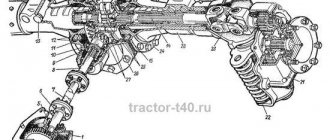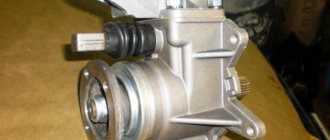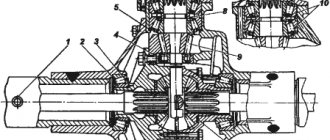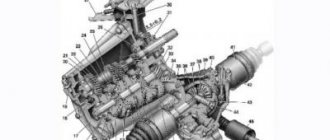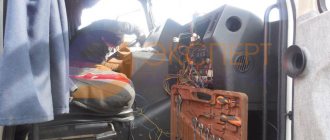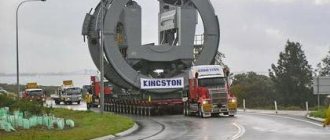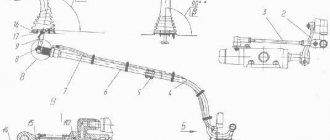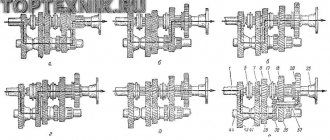Weight of Units and Bodywork - DRIVE2
While rummaging through the Internet I found this information, I think it will be useful to everyone.
Power unit assembly (with gearbox and transfer case)
GAZ-67 engine with gearbox and transfer case (transfer case is integrated into the gearbox) - 248 kg GAZ-69 engine with gearbox and transfer case - 280 kg GAZ-66 engine with gearbox and transfer case - 380 kg ZIL-130 engine (431410) with gearbox and parking brake - 640 kg UAZ-3151 (UMZ-4179) engine with gearbox and transfer case - 240 kg Engine
GAZ-66 engine - 275 kg ZIL-130 engine (431410) - 500 kg UAZ-3151 engine (UMZ-4179) - 165 with clutch Mitsubishi 4D56 engine - 215 kg Mitsubishi 4G64 engine - 195 kg Mitsubishi 4M40 engine - 2 70 kg Mitsubishi engine 6G72 - 225 kg Nissan TD27 engine - 250 kg Nissan RD28 engine - 255 kg Nissan TD42 engine - 365 kg Toyota 1HDFTE engine - 365 kg HUYNDAI D4BH engine - 220 kg VAZ engine 21214-1000260-32 - 134.5 kg VAZ engine 21213- 1000260-00 - 124 kg VAZ 2121 engine - 114 kg
GAZ-66 gearbox - 56 kg ZIL-130 gearbox (431410) without parking brake - 98 kg GAZ-69 gearbox - 28 kg UAZ 3151 gearbox - 36 kg Mitsubishi V5MT1 gearbox (manual transmission) with SuperSelect transfer case - 110 kg Mitsubishi V4AW3 gearbox (automatic transmission) with SuperSelect transfer case - 140 kg VAZ-2121 gearbox (with clutch housing) - 32 kg
GAZ 53 truck, modifications and weight of the special model
In the Russian space, one of the most common and popular small-tonnage vehicles was the GAZ 53 truck. Even today it can be found in almost every city. Over the entire production period, which took more than 30 years, the machine was constantly modernized and slightly changed. Its latest version was the GAZ 53 12, production of which began in 1983.
History of creation
The cars of the Gorky Automobile Plant are among the oldest and most popular Soviet brands. There were the following modifications of the GAZ 53:
- 53F - from 1961 to 1967;
- 53A - from 1965 to 1983;
- 53-12 – from 1983 to 1993.
The developer made the first car in 1959, but mass production began only in 1961. The number of vehicles produced in the entire history of their assembly exceeded 4 million units.
October 1961 marked the beginning of production of the GAZ 53 F, which is a 3.5-ton vehicle with 82 horsepower. In 1954, production of the Model 53 began, the weight of which reached 9 tons and the power of 114 horsepower. Later the name was changed to 53A. The car was produced in various versions until 1983. Significant changes between them were only in the chassis used.
Since 1983, the GAZ-5312 has been in production for 10 years, which increased its carrying capacity, acquired several new parts, modernized certain types of units, etc.
In 1990, an additional model called GAZ 3307 appeared for a short time, but its production was short-lived and not as popular as before.
Special models
In addition to basic models, the manufacturer produced a number of special vehicles based on the Lawn. Their differences lay in the type of body used and the purpose.
The GAZ 53 onboard was always considered the basic option. But the plant has also developed options for a dump truck and a truck tractor. In the first case, a chassis called 53 02 was used. It was on it that structures for transporting goods were located. At the same time, the GAZ 53 truck tractor was equipped with the GAZ 53 05 chassis.
For the army, the plant produced a special model 53N. First of all, the car was distinguished by its tactical and technical characteristics. In addition, the weight of the GAZ 53 onboard was slightly less than the military version of the vehicle.
It is also worth noting that the GAZ 53, used as a truck tractor, was not widespread. This was primarily due to the low power of each modification of the car.
Truck Specifications
One of the indicators of the GAZ 53 is the weight of the car, which is only 3.2 tons. Its total weight is 7.85 tons. Thus, the vehicle’s carrying capacity is 4.5 tons. But such indicators only apply to modification 53 12, for which the cars were designed for only 3 tons of cargo.
Model 53 dimensions are as follows:
| Body length | 6.4 meters |
| Body width | 2.4 meters |
| Body height over cabin | 2.2 meters |
| Axle distance | 3.7 meters |
| Wheel track on the front beam | 1.63 meters |
| Wheel track on the rear beam | 1.69 meters |
| Clearance | 0.265 meters |
| Wheel tires | 8.25-20 inches |
The permissible vehicle speed is 90 kilometers per hour. But in reality, it can go much faster if the load is not very large. The car's fuel consumption is 24 liters per 100 kilometers. But most often this figure rises due to excessive loads and poor car care.
The car's power unit is a V-shaped carburetor engine with 8 cylinders. Its volume is 4252 cubic centimeters. The engine requires 10 liters of oil. The gearbox has 4 gears and 1 reverse. The fuel tank capacity is 90 liters. The car runs on A-76 gasoline.
Rear axle inspection
In order to inspect all the parts of the rear axle, you must first soak these parts in a washing solution. This does not apply to bearings. Next, the parts must be thoroughly washed and inspected. Those parts on which you find cracks must be replaced without fail.
This is what the rear axle gearbox looks like.
Its weight is 69 kg.
Now let's begin inspecting the drive and driven gears. This is where we look for wear or scoring. If there is even one flaw, it is better to immediately change the gear; there is no need to try to repair it. The effect will not last long.
After this, you can proceed to the bearing rings. Here they need to be inspected for scoring and uneven wear. Particular attention should be paid to the ends of the rollers.
Construction of the Gas 53 bridge.
To check that the nuts are screwed in, you need to install the bearing cap and tighten the nuts. If the nuts turn without any problems, then everything is fine. You should immediately inspect the end of the driveshaft flange, which is connected to the drive gear bearing. The end must be perfectly smooth. If it doesn't, then sand it down.
The oil passages on the bearing coupling must be periodically cleaned. Inspect it for damage, burrs, etc.
Make sure that the bearings fit snugly on all bearing surfaces, this will ensure that your differential will last for a long time. You should also check the runout of the driven gear. If the runout does not correspond to the norm, then look for the reason for this in the gear, which may have been deformed. Or maybe the differential box is damaged or the bearing is worn out.
Rear axle malfunctions
There are certain signs by which you can determine that the rear axle needs adjustment, repair or replacement. The most noticeable and banal sign is if the car does not move and its rear wheels do not spin. This can happen if the bridge has been running for some time without any lubrication at all. But this happens quite rarely - not all drivers bring their car to such a deplorable state. Also, the car will not move if the axle shaft breaks.
A sign of a faulty bridge is:
- When accelerating with a load, there is a howling noise in the area of the rear axle. It happens that an extraneous sound occurs when the speed is reduced at a certain speed limit. The reason may be an incorrectly adjusted gap in the main pair, wear of the gear teeth in it.
Rear axle from GAZ 53 disassembled.
The sound in the axle is very similar to the howling in the gearbox, so it is advisable to ask someone to climb into the back to listen to where the noise is coming from; - Oil leakage from the gearbox shank or in the area of the rear wheel hubs. The cause of the leak may be seals or a clogged breather. If leakage occurs in the area where the axle gearbox is attached to the crankcase, then most likely the paronite gasket is leaking or the fastenings are not tightened.
Information - How much does a truck weigh?
There are times when you need to know the weight of a truck without cargo, the so-called empty weight. But how can you find out if there are no truck scales nearby, and it is not possible to weigh the truck.
On this page we provide a table showing the weight values of the most common models and brands of trucks.
How much does a truck weigh? How to find out the weight of a truck?
The answer to this fairly common question is in the table below.
| Utility vehicles | Truck weight in kg |
| How much does a Gazelle weigh (weight of a Gazelle 3302 car) | 1850 kg |
| How much does Gazelle weigh (weight of Gazelle car 33023) | 2050 kg |
| How much does a Gazelle weigh (weight of a Gazelle car 33027, 330202) | 2100 kg |
| How much does Gazelle weigh (weight of Gazelle car 330273) | 2300 kg |
| How much does a Gazelle weigh (weight of a Gazelle 2705 car) | 2000 kg |
| How much does Gazelle weigh (weight of Gazelle car 330232) | 2220 kg |
| How much does Gazelle weigh (weight of Gazelle car 2752) | 2170 kg |
| How much does Sobol 2752 weigh (weight of the Sobol 2752 car) | 1880 kg |
| How much does Sobol 2217 weigh (weight of car Sobol 22171) | 2130 kg |
| Trucks | |
| How much does GAZ 53 weigh (weight of GAZ 53 truck) | 3250 kg |
| How much does GAZ 66 weigh (weight of GAZ 66 truck) | 3440 kg |
| How much does GAZ 69 weigh (weight of GAZ 69 truck) | 1525 kg |
| How much does GAZ 69A weigh (weight of GAZ 69A truck) | 1535 kg |
| How much does a ZIL car weigh (weight of a ZIL 130 truck) | 4300 kg |
| How much does a ZIL car weigh (weight of a ZIL 131 truck) | 6790 kg |
| How much does a ZIL car weigh (weight of a ZIL 157KD truck) | 5050 kg |
| How much does a ZIL car weigh (weight of a ZIL truck 433360 | 4475 kg |
| How much does a ZIL car weigh (weight of a ZIL 431410 truck) | 4175 kg |
| How much does a ZIL car weigh (weight of a ZIL 431510 truck) | 4550 kg |
| How much does a MAZ 5551 car weigh (weight of a MAZ 5551 truck) | 7470 kg |
| How much does a MAZ 53366 car weigh (weight of a MAZ 53366 truck) | 8200 kg |
| How much does the Ural 375 weigh (weight of the URAL 375 truck) | 7700-8000 kg |
| How much does the Ural 377 weigh (weight of the URAL 377 truck) | 6830-7275 kg |
| How much does the Ural 4320 weigh (weight of the URAL 4320 truck) | 9750 kg |
| How much does Ural 5557 weigh (weight of URAL 5557 truck) | 9980 kg |
Front axle
The front axle on the GAZ 53 truck is a massive beam, which is the supporting basis for the entire front suspension. The beam has an I-section, its ends have eyes for installing rotary axles using a pin connection. The axles (steering knuckles), in turn, are connected to steering rods, through which the wheels turn. Bronze or brass bushings are pressed into the seats (eyes) under the pivots. The steering knuckles are mounted on the front wheel hub bearings; the bearings are filled with thick grease of the “litol” type.
Front axle malfunctions
Only one problem can happen to the beam itself - the seats for the pin bushings will be worn out. It is not easy to bend or break such a massive element. But first of all, the pins and the bushings themselves wear out.
Drawing of the front axle for GAZ 53
In order for the pivot joint to serve for a long time, it is necessary to regularly spray it with lithol or other grease. For injection, special grease nipples are provided on the suspension - they are located on the lower and upper bosses of each pivot pin.
A sign of a front axle malfunction may be a knocking sound in the area of the front wheels. The knocking occurs due to increased play in the pivot joints.
It is not difficult to determine the defect - you need to hang one front wheel on a jack and rock it up and down. It is believed that if the play is more than 1.6 mm, the kingpins and bushings must be replaced. But how these millimeters are measured is not very clear. It’s just that if there is a noticeable gap, it’s time to repair the front axle. The wheel bearings on the front axle may be noisy. The defect of the front bearing is checked in the same way as on the rear axle - the wheel is hung up and rotated.
Checking the bearing of the front axle GAZ 53
If a defect is detected, the faulty parts are replaced.
